Boeing Houston conducted an Engineering Development Test in a mockup of the International Space Station Airlock with the assistance of personnel from many different organizations, including NASA/JSC, NASA/MSFC, Energia, and their contractors. Several people, including Ilia Rosenberg, Jeff Rouze, and Ross Drake, took pictures with digital cameras and left copies of them on my computer. These are some of the best pictures I found.
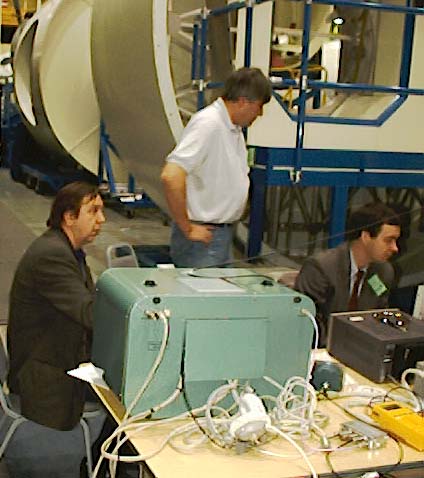 Victor Korolev, Eugene Filimonov, and Igor Smirnov.
The big turquoise box is the
electrical ground support equipment for the Russian Orlan space suit.
You can also see a Russian headset in the foreground.
Victor Korolev, Eugene Filimonov, and Igor Smirnov.
The big turquoise box is the
electrical ground support equipment for the Russian Orlan space suit.
You can also see a Russian headset in the foreground.
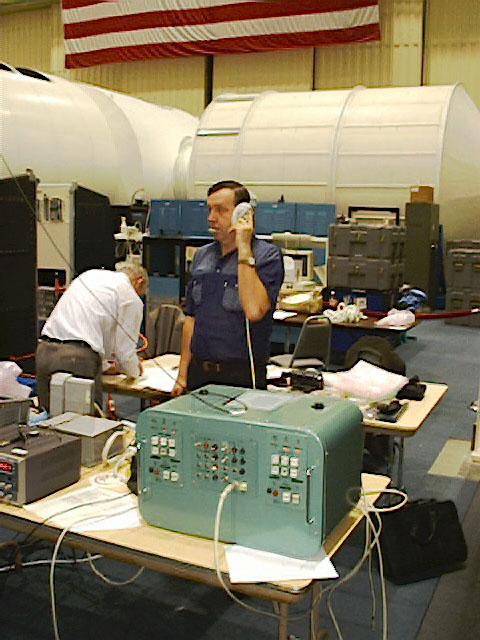 Another view of the same general area, but with Victor Korolev
wearing a headset and Boris Levov writing something in the background.
Another view of the same general area, but with Victor Korolev
wearing a headset and Boris Levov writing something in the background.
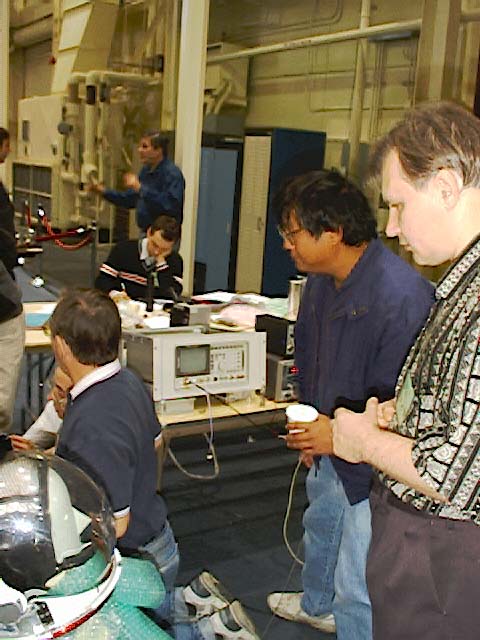 Andy Eng and Victor Gontcharouk look on as a JSC contractor works
on the UIA (not shown here).
In the foreground left is an acoustic test mannequin, also
called The Dummy.
It is wearing a Russian EVA headset, a U.S. helmet,
and an "ascot" made of bubble wrap.
Andy Eng and Victor Gontcharouk look on as a JSC contractor works
on the UIA (not shown here).
In the foreground left is an acoustic test mannequin, also
called The Dummy.
It is wearing a Russian EVA headset, a U.S. helmet,
and an "ascot" made of bubble wrap.
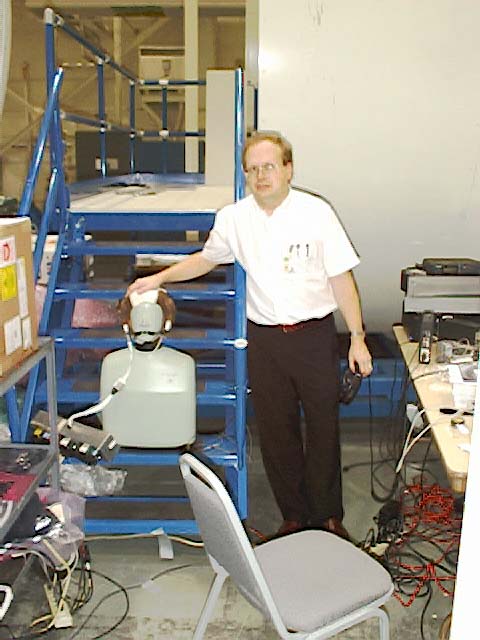 Me with the dummy, here seen wearing a nonflight U.S. EVA headset.
Me with the dummy, here seen wearing a nonflight U.S. EVA headset.
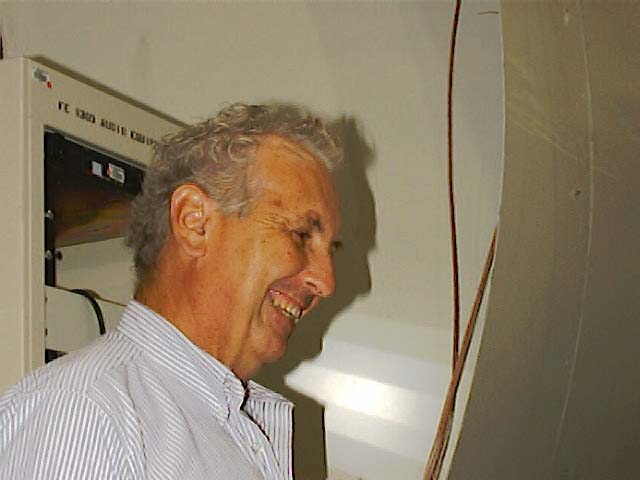 Ross Drake of Boeing Huntsville.
Why is this man smiling?
Ross Drake of Boeing Huntsville.
Why is this man smiling?
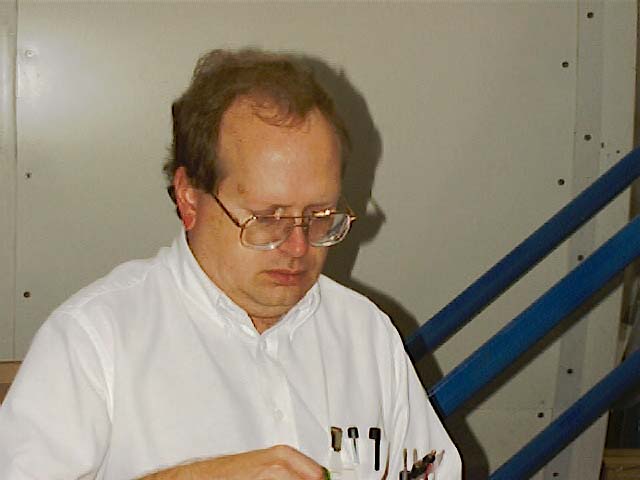 An unflattering portrait of yours truly.
No, I'm not asleep.
An unflattering portrait of yours truly.
No, I'm not asleep.
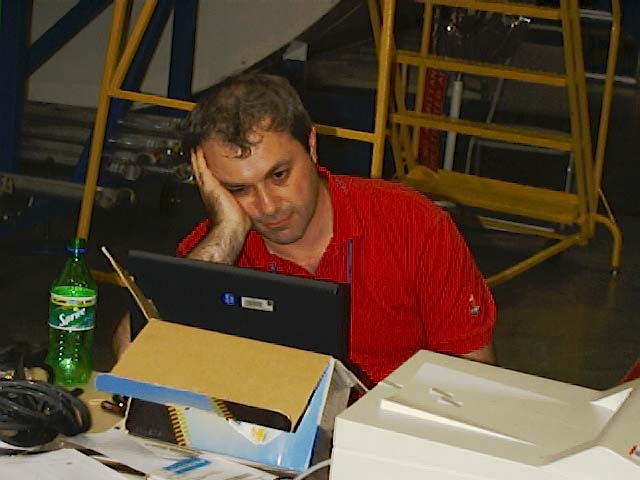 Ilia Rosenberg of Boeing Houston, our Fearless Leader, after a bad day.
Ilia Rosenberg of Boeing Houston, our Fearless Leader, after a bad day.
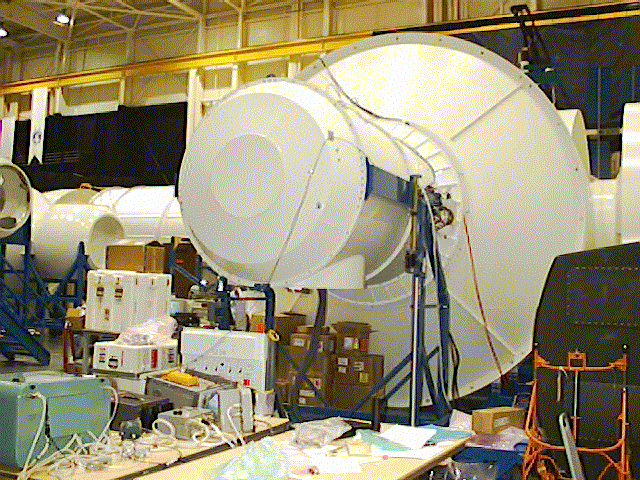 A picture of the Airlock from the crew lock side.
The hatch to the outside is facing straight down.
The Node 1 mockup is on the other side of the Airlock.
The orange framework on the right side is the handling fixture for
the Russian (Orlan) suit.
A picture of the Airlock from the crew lock side.
The hatch to the outside is facing straight down.
The Node 1 mockup is on the other side of the Airlock.
The orange framework on the right side is the handling fixture for
the Russian (Orlan) suit.
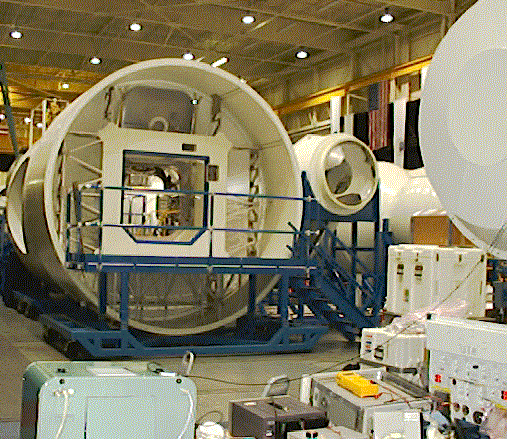 A picture of some of the modules on the mockup floor.
I'm not certain which are which in this picture,
and it didn't help any that they were constantly shuffling them around
and, in some cases, lifting them overhead.
The smallish round contraption
to the right of the middle is a mockup of a PMA from the skinny side.
The UIA may be seen at the lower right.
A picture of some of the modules on the mockup floor.
I'm not certain which are which in this picture,
and it didn't help any that they were constantly shuffling them around
and, in some cases, lifting them overhead.
The smallish round contraption
to the right of the middle is a mockup of a PMA from the skinny side.
The UIA may be seen at the lower right.
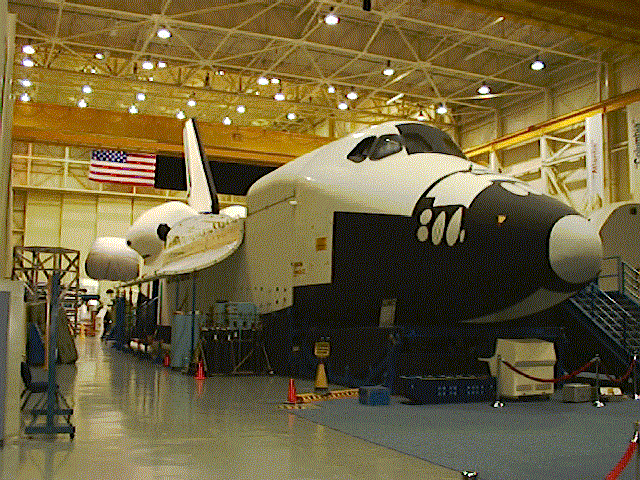 Speaking of mockups, in the northeast side of 9NW,
there are several Shuttle mockups.
Here's one of them.
In the background is a large yellow crane which was used to pick
up stuff in the building.
It made a fair amount of noise when it was being
moved, all the more so because they rang a bell every time they moved it.
Another noise source was a tour that passed through a corridor to the left
that you can't see here or in any of the other shots I have.
It was at the second-floor level.
The tour guides gave the same spiel every time
the tour came through, which was often--even more so on the weekends.
The tour guides made reference to "engineers and scientists working behind
the scenes," a comment that I thought was slightly insulting.
All of these noises probably made it to my test tapes, unfortunately.
Speaking of mockups, in the northeast side of 9NW,
there are several Shuttle mockups.
Here's one of them.
In the background is a large yellow crane which was used to pick
up stuff in the building.
It made a fair amount of noise when it was being
moved, all the more so because they rang a bell every time they moved it.
Another noise source was a tour that passed through a corridor to the left
that you can't see here or in any of the other shots I have.
It was at the second-floor level.
The tour guides gave the same spiel every time
the tour came through, which was often--even more so on the weekends.
The tour guides made reference to "engineers and scientists working behind
the scenes," a comment that I thought was slightly insulting.
All of these noises probably made it to my test tapes, unfortunately.
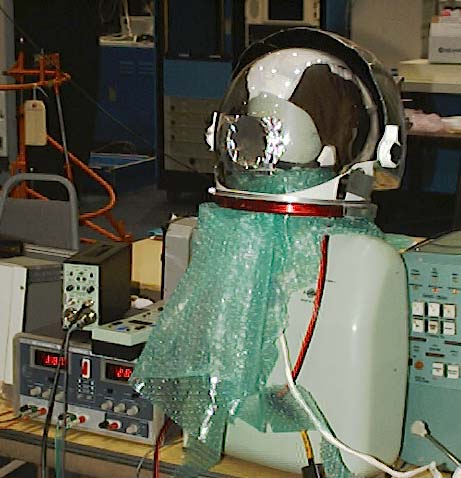 The dummy again.
The helmet is from Ilia's EVA suit simulator, which is designed for a person
(usually Ilia) to wear.
Therefore, there is a hole in the front of the helmet to breathe through.
However, we had to plug up the hole with tape
to make it less acoustically transparent.
There were various jokes about
how the dummy was suffocating and starting to turn green, etc.
The dummy again.
The helmet is from Ilia's EVA suit simulator, which is designed for a person
(usually Ilia) to wear.
Therefore, there is a hole in the front of the helmet to breathe through.
However, we had to plug up the hole with tape
to make it less acoustically transparent.
There were various jokes about
how the dummy was suffocating and starting to turn green, etc.
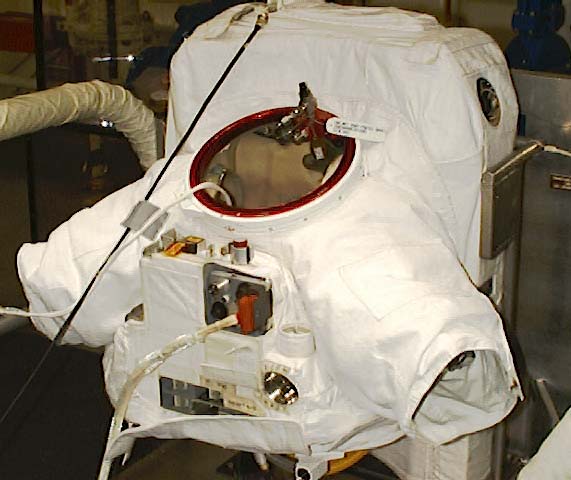 This is just about all we got of a U.S. EVA suit.
And it was mounted semi-permanently on a cart.
There is a valve fitted in the neck ring, so we couldn't put the
dummy in it if we tried, and we didn't.
The suit ran on batteries, and we had to have one of Joey Marmolejo's
people turn the suit on and off for each test to keep from draining
the batteries.
This is just about all we got of a U.S. EVA suit.
And it was mounted semi-permanently on a cart.
There is a valve fitted in the neck ring, so we couldn't put the
dummy in it if we tried, and we didn't.
The suit ran on batteries, and we had to have one of Joey Marmolejo's
people turn the suit on and off for each test to keep from draining
the batteries.
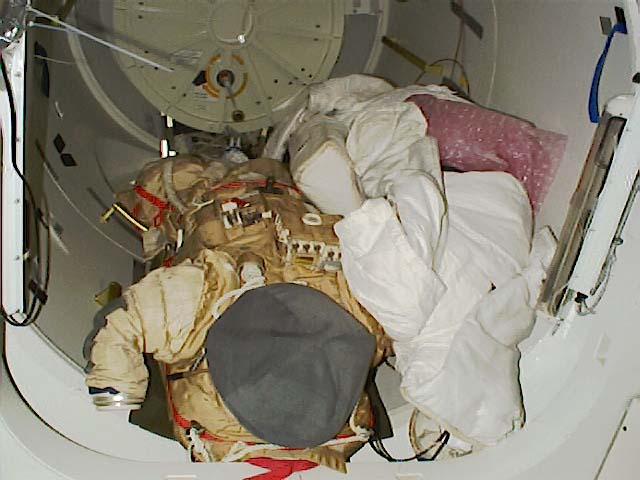 This picture was taken from inside the Equipment Lock looking into
the Crew Lock.
The suit on the left is the Russian Orlan (pronounced like "orlon")
suit, which is made by Zvezda.
This particular one had been deorbited from Mir.
It lacks a helmet and gloves.
The Orlan suit antenna is a unique design.
Basically, the top and bottom halves of the suit form a dipole antenna.
The mass of white stuff to the right is Ilia's suit simulator,
minus helmet.
Ilia had stuffed it full of bubble plastic, but it was still pretty
shapeless.
The handrail antenna is at the far end of the Crew Lock on the upper
side, so you can't see it from here.
You can see it, however, in the next picture.
This picture was taken from inside the Equipment Lock looking into
the Crew Lock.
The suit on the left is the Russian Orlan (pronounced like "orlon")
suit, which is made by Zvezda.
This particular one had been deorbited from Mir.
It lacks a helmet and gloves.
The Orlan suit antenna is a unique design.
Basically, the top and bottom halves of the suit form a dipole antenna.
The mass of white stuff to the right is Ilia's suit simulator,
minus helmet.
Ilia had stuffed it full of bubble plastic, but it was still pretty
shapeless.
The handrail antenna is at the far end of the Crew Lock on the upper
side, so you can't see it from here.
You can see it, however, in the next picture.
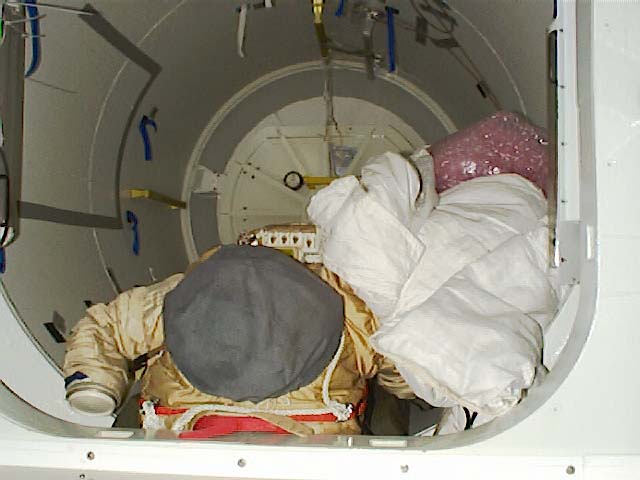 Same thing from a different angle.
The antenna is the silver-colored handrail at about 1:00.
I think that it is supposed to replace the brass-colored one, but
that would have been too much trouble for our test.
Same thing from a different angle.
The antenna is the silver-colored handrail at about 1:00.
I think that it is supposed to replace the brass-colored one, but
that would have been too much trouble for our test.
 The Umbilical Interface Adaptor (I think) is a panel that is
designed to service two suits, Russian (Orlan) or U.S. (EMU).
This is actually the flight unit.
The suit connections are made at the two square openings in the panel.
The owners of the UIA didn't want us touching any of the water or
oxygen connections, so they covered them with plastic when we weren't
using them.
The rectangular opening at the bottom is for a panel that we didn't
need for the test.
The panel is only a few inches thick and has mostly exposed metal
plumbing behind the panel.
The panel was mounted on a stand with wheels.
The Umbilical Interface Adaptor (I think) is a panel that is
designed to service two suits, Russian (Orlan) or U.S. (EMU).
This is actually the flight unit.
The suit connections are made at the two square openings in the panel.
The owners of the UIA didn't want us touching any of the water or
oxygen connections, so they covered them with plastic when we weren't
using them.
The rectangular opening at the bottom is for a panel that we didn't
need for the test.
The panel is only a few inches thick and has mostly exposed metal
plumbing behind the panel.
The panel was mounted on a stand with wheels.
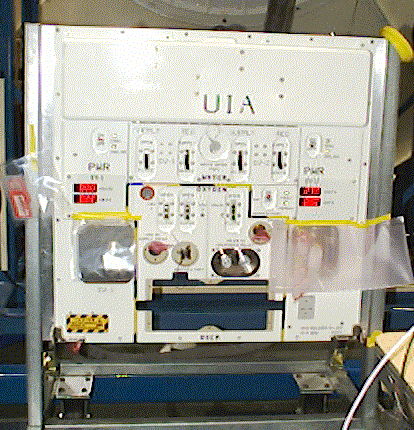 This shows the UIA mounted on its stand.
This shows the UIA mounted on its stand.
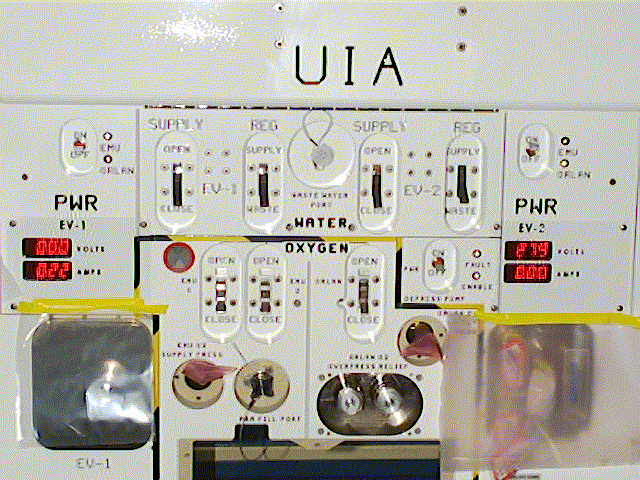 A closeup picture of the UIA in case you want to read all of the writing.
A closeup picture of the UIA in case you want to read all of the writing.
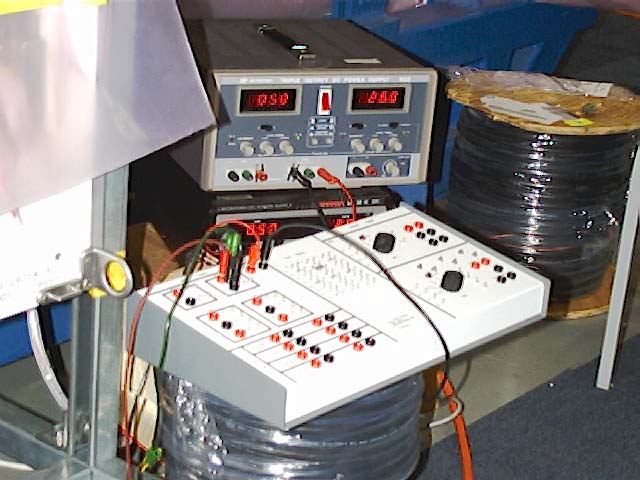 This was a piece of EGSE supporting the UIA.
This was a piece of EGSE supporting the UIA.
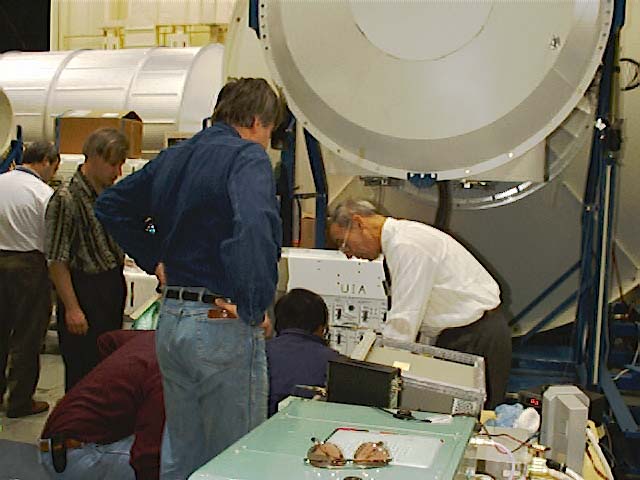 One morning, we had a communications problem that we initially feared
was caused by the UIA.
There were a lot of people helping to troubleshoot the UIA.
From left to right, Ilia Rosenberg, Victor Gontcharouk, Ross Drake
(kneeling), Eugene (standing), Andy Eng, and Leonid Chernikov.
One morning, we had a communications problem that we initially feared
was caused by the UIA.
There were a lot of people helping to troubleshoot the UIA.
From left to right, Ilia Rosenberg, Victor Gontcharouk, Ross Drake
(kneeling), Eugene (standing), Andy Eng, and Leonid Chernikov.
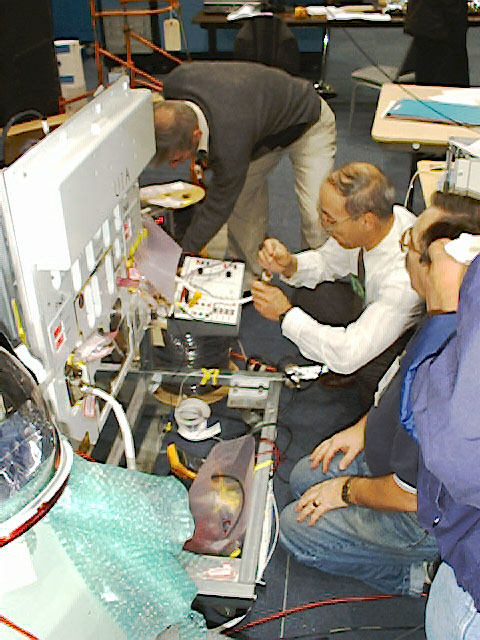 More UIA troubleshooting.
More UIA troubleshooting.
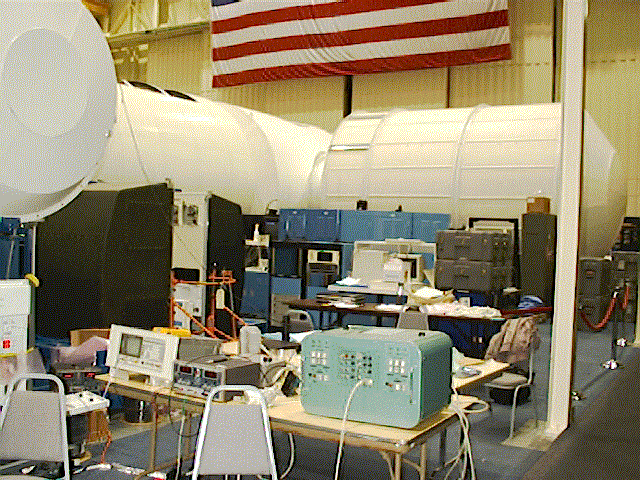 Another view of the Russian equipment setup.
The RF analyzer at the left is Jeff's, and the power supply
just to the right of it was loaned to us by Andy Romero.
The module layout, from right to left, is COF, Node 2, U.S. Lab, and
Airlock.
There is a JEM on the opposite side of Node 2 from the COF, but you
can't see it.
Most of the equipment in the background seems to be associated with
an educational outreach program in which various JSC contractors
videocon with classrooms in other parts of the U.S.
Another view of the Russian equipment setup.
The RF analyzer at the left is Jeff's, and the power supply
just to the right of it was loaned to us by Andy Romero.
The module layout, from right to left, is COF, Node 2, U.S. Lab, and
Airlock.
There is a JEM on the opposite side of Node 2 from the COF, but you
can't see it.
Most of the equipment in the background seems to be associated with
an educational outreach program in which various JSC contractors
videocon with classrooms in other parts of the U.S.
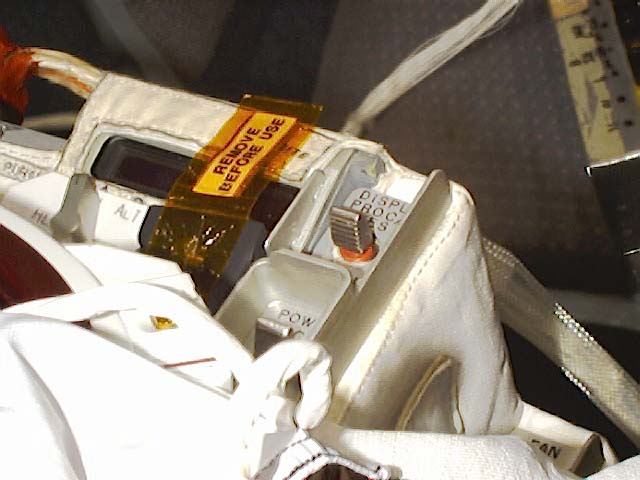 This is a view of the Displays and Controls Module in the front
of the EMU.
Just a few big switches and some meters.
This is a view of the Displays and Controls Module in the front
of the EMU.
Just a few big switches and some meters.
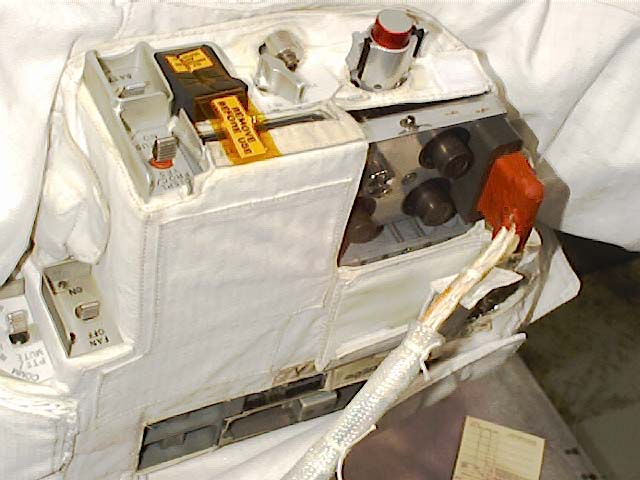 Another view of the DCM.
The electrical connection at the front goes to the UIA.
Another view of the DCM.
The electrical connection at the front goes to the UIA.
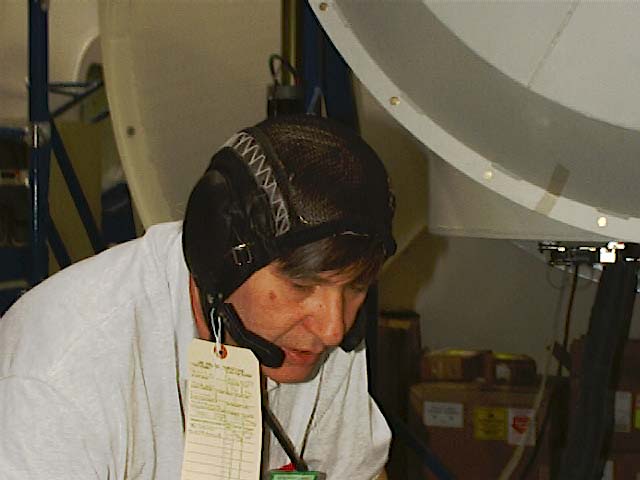 Eugene models the Orlan headset in Minnie Pearl fashion.
It's a JSC parts tag.
Eugene models the Orlan headset in Minnie Pearl fashion.
It's a JSC parts tag.
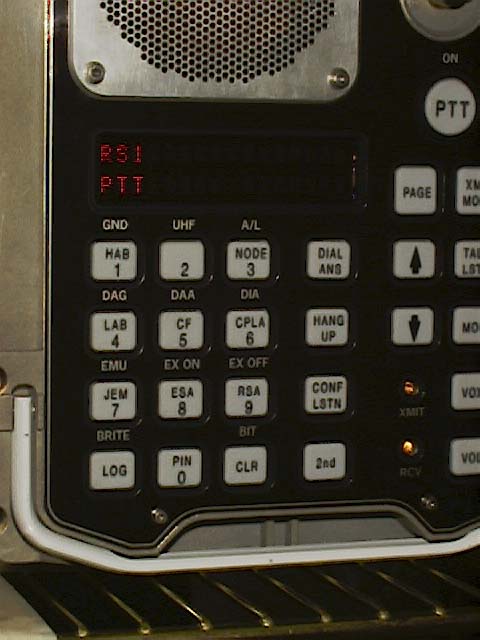 For those of you with a handful of gravel, here is the front panel
of the Harris Audio Terminal Unit.
This is a non-flight unit; you can tell because its sides are not
white.
During the test, we were told that the Astronaut Office was recommending
a complete redesign of the front panel.
For those of you with a handful of gravel, here is the front panel
of the Harris Audio Terminal Unit.
This is a non-flight unit; you can tell because its sides are not
white.
During the test, we were told that the Astronaut Office was recommending
a complete redesign of the front panel.
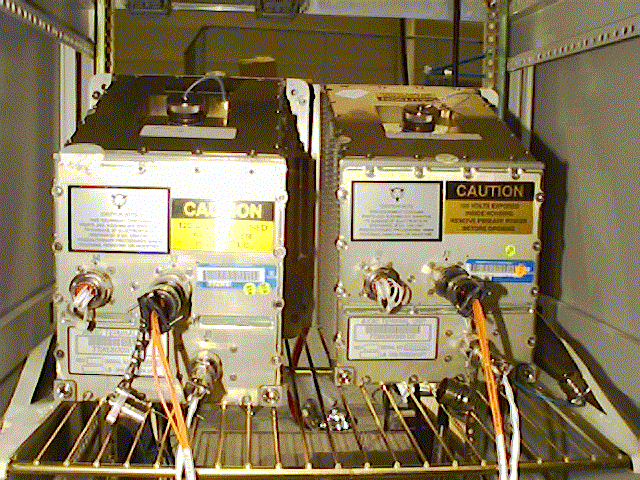 The two ATUs from the back.
Your eyes are not deceiving you; there are 3 (not 2, not 4) fibers connected
to each of these ATUs.
The best explanation I have received for this is "That's the way the
cable was made."
Also visible are the address and power connectors projecting from the
back panel.
The capped connector at the top is not for ordinary mortals.
The two ATUs from the back.
Your eyes are not deceiving you; there are 3 (not 2, not 4) fibers connected
to each of these ATUs.
The best explanation I have received for this is "That's the way the
cable was made."
Also visible are the address and power connectors projecting from the
back panel.
The capped connector at the top is not for ordinary mortals.
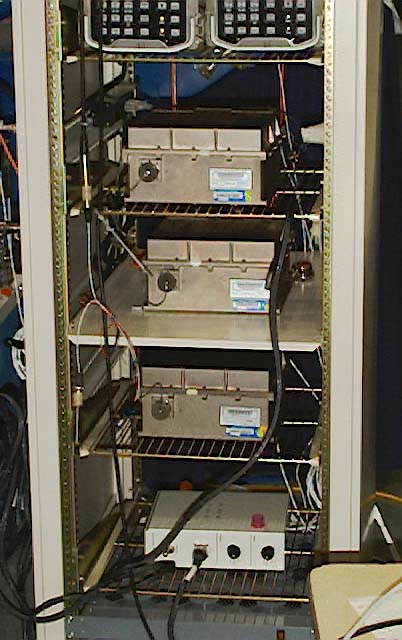
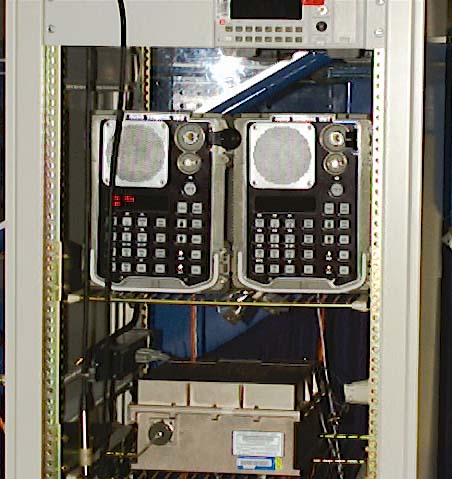
Two views of the rack holding the Harris audio boxes and the EVA Audio
Control Panel.
The latter is the narrow box sitting on its side in the bottom of the
rack.
The rack is, by the way, the FE1309 test set.
At the top of the rack is a power supply (not shown) and a piece of
HP fiber optic test equipment, neither of which was used for the test.
Just below the two ATUs are an Audio Bus Coupler (ABC), Audio Interface
Unit (AIU, in RAIU mode), and an ACS/UCS Audio Interface (AUAI), but
I cannot remember which is which any more because all of those boxes
look the same except for the labels, which you cannot read from the
picture.
The EACP has a front-panel connector which connects to a Y-cable which
connects to the headset connectors on the two ATUs.
It also has two PTT/Dual/VOX mode switches and a power switch.
None of these boxes run particularly hot to the touch
and are adequately cooled just as shown.
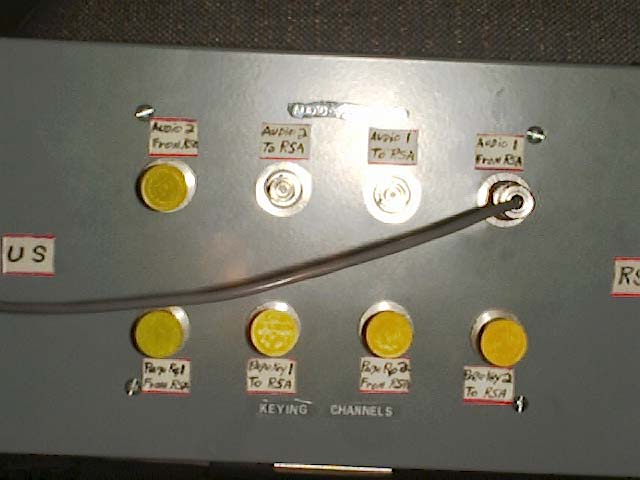 Bill Baker made this breakout box for the U.S./Russian audio interface
test that was held in my lab years ago.
I am including it so that if it ever gets lost, I
can tell people that it looked like this.
Bill Baker made this breakout box for the U.S./Russian audio interface
test that was held in my lab years ago.
I am including it so that if it ever gets lost, I
can tell people that it looked like this.
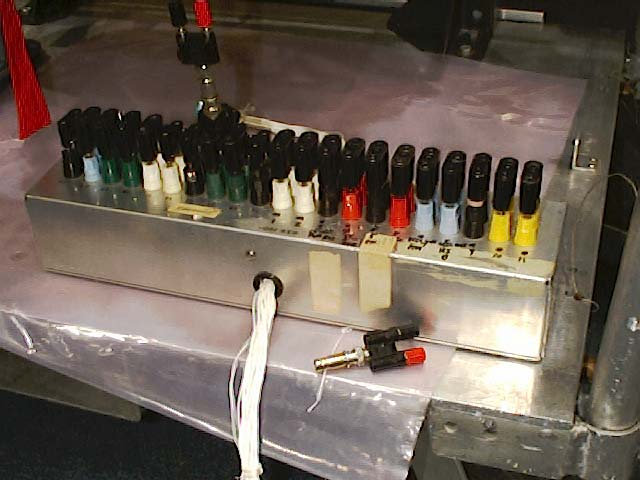 Breakout boxes are so beautiful, eh?
This one is inserted between the EMU headset (Crew Communication
Assembly or CCA) and the EMU or the SSER, whichever you happen to be using.
We had to relinquish this box briefly during the test because ESTL needed
it.
Breakout boxes are so beautiful, eh?
This one is inserted between the EMU headset (Crew Communication
Assembly or CCA) and the EMU or the SSER, whichever you happen to be using.
We had to relinquish this box briefly during the test because ESTL needed
it.
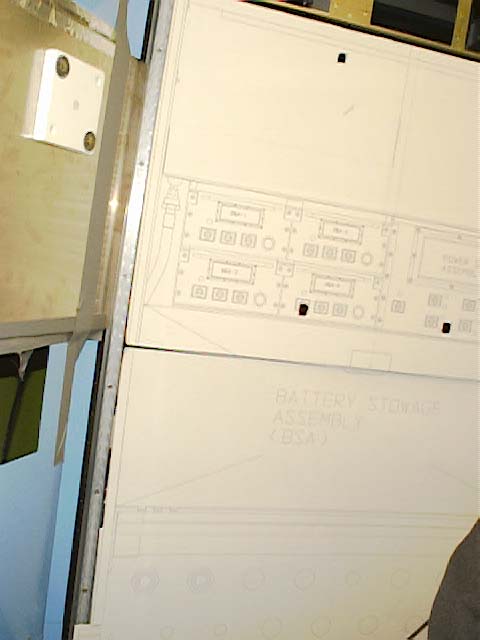 This picture was taken inside the Equipment Lock facing one of the
side walls.
The white square on the left is the patch antenna.
This picture was taken inside the Equipment Lock facing one of the
side walls.
The white square on the left is the patch antenna.
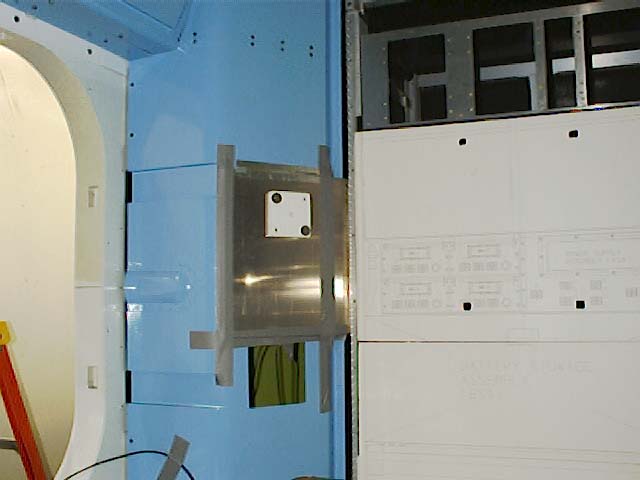 A longer view of the same general area, with the patch antenna almost
in the center.
The four rectangular cutouts in the rack at the upper right are for EMU ATU
1, EMU ATU 2, EACP, and Airlock ATU, from left to right.
A longer view of the same general area, with the patch antenna almost
in the center.
The four rectangular cutouts in the rack at the upper right are for EMU ATU
1, EMU ATU 2, EACP, and Airlock ATU, from left to right.
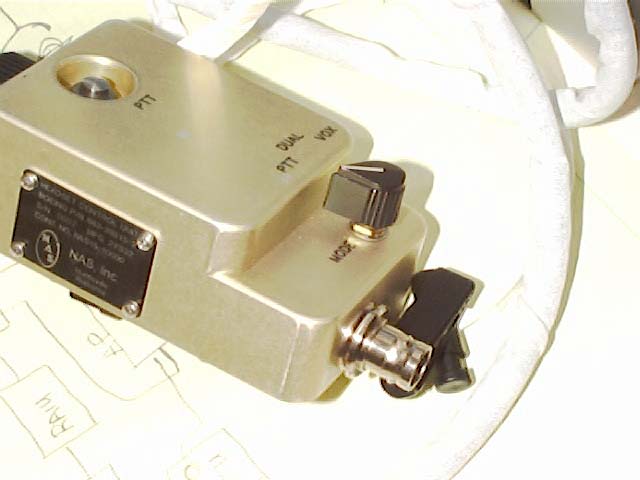 A close-up
of the Headset Control Unit that is a part of the U.S. audio system. There
is a PTT button and a mode selector switch, plus a headset volume control
on the upper left side. The connector on this end of the HCU connects to
the cable going to an ATU. This connector has a slightly weird release
mechanism compared to other LEMO connectors; you release it by pushing
in on the ring next to the jam nut.
A close-up
of the Headset Control Unit that is a part of the U.S. audio system. There
is a PTT button and a mode selector switch, plus a headset volume control
on the upper left side. The connector on this end of the HCU connects to
the cable going to an ATU. This connector has a slightly weird release
mechanism compared to other LEMO connectors; you release it by pushing
in on the ring next to the jam nut.
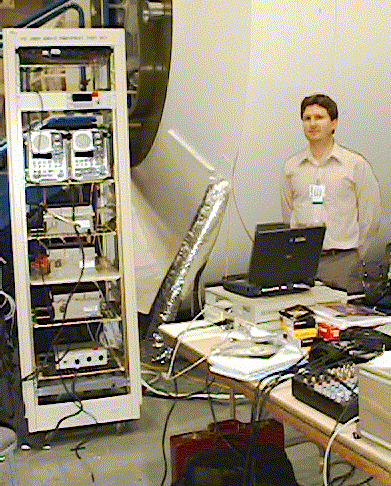 On the left is the rack
full of U.S. audio equipment.
Jeff Rouze, who works for Hernandez Engineering
and operated the SSCS equipment, is at the right. The laptop computer at
center is sitting atop the Audio Precision System One audio analyzer that
we used extensively during these tests. There's also a Mackie mic mixer
and a bunch of blank tapes on the table.
On the left is the rack
full of U.S. audio equipment.
Jeff Rouze, who works for Hernandez Engineering
and operated the SSCS equipment, is at the right. The laptop computer at
center is sitting atop the Audio Precision System One audio analyzer that
we used extensively during these tests. There's also a Mackie mic mixer
and a bunch of blank tapes on the table.
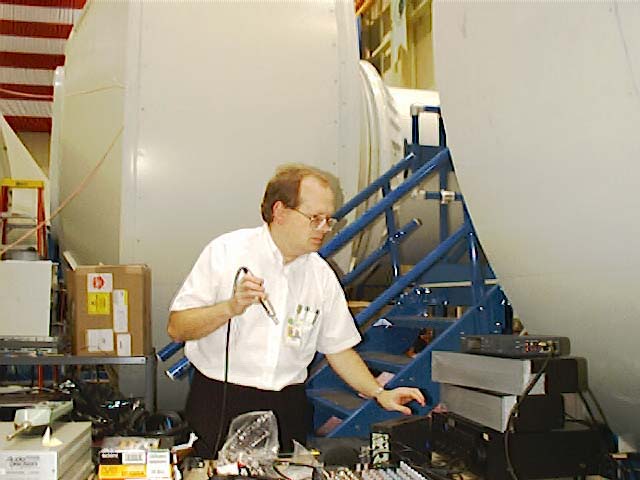 It looks like I'm
about to do something, but I can't remember what. Ross and I came in on
a Saturday and equalized the dummy's mouth and ear response to as flat
as I could get them using the two equalizers on the right with "gaffer's
tape" applied to the front of the equalizers. The tape was there to keep
people (including myself) from monkeying with the sliders. There is a B&K
sound level meter at the left on top of the Audio Precision box. The equipment
lock is behind me. I'm not certain what the element on the right (with
the staircase) is.
It looks like I'm
about to do something, but I can't remember what. Ross and I came in on
a Saturday and equalized the dummy's mouth and ear response to as flat
as I could get them using the two equalizers on the right with "gaffer's
tape" applied to the front of the equalizers. The tape was there to keep
people (including myself) from monkeying with the sliders. There is a B&K
sound level meter at the left on top of the Audio Precision box. The equipment
lock is behind me. I'm not certain what the element on the right (with
the staircase) is.
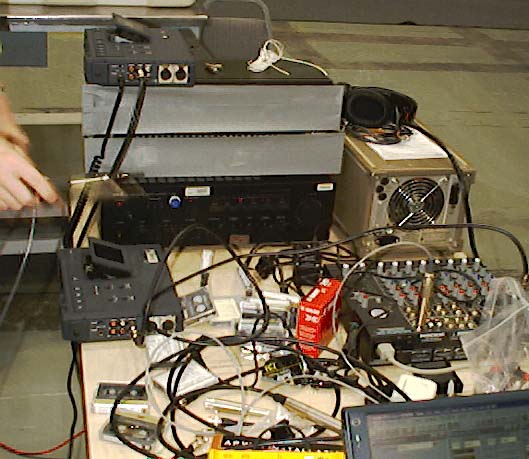 If you think this
nest of cables is wild, you should see the mess under the table. At the
upper left is one of the two Tascam DA-P1 portable DAT recorders I used;
the other one is sitting on the table on front of it. The two equalizers
are shown, and below them is an old Yamaha amplifier that was actually
acquired from an old contract we had with Hughes Aircraft back in the Advanced
Development days. To the right is a small Tektronix scope borrowed from
Andy Romero. In front of that is a Mackie mixer (little used during this
test), and you can also make out a little bit of the Audio Precision software
display on the laptop screen at lower right.
If you think this
nest of cables is wild, you should see the mess under the table. At the
upper left is one of the two Tascam DA-P1 portable DAT recorders I used;
the other one is sitting on the table on front of it. The two equalizers
are shown, and below them is an old Yamaha amplifier that was actually
acquired from an old contract we had with Hughes Aircraft back in the Advanced
Development days. To the right is a small Tektronix scope borrowed from
Andy Romero. In front of that is a Mackie mixer (little used during this
test), and you can also make out a little bit of the Audio Precision software
display on the laptop screen at lower right.
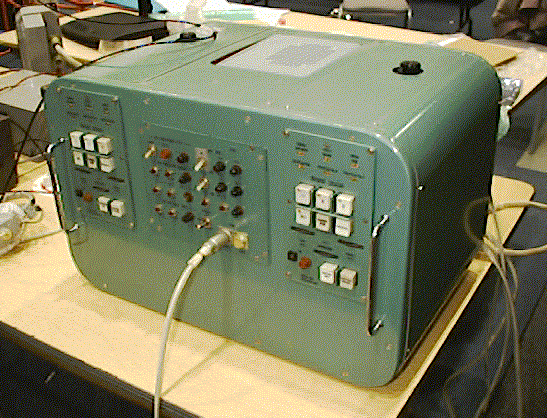 The EGSE for the Russian
(Orlan) suit. All of the writing is in Russian, so you're probably not
missing much by not being able to read it in this photo.
The EGSE for the Russian
(Orlan) suit. All of the writing is in Russian, so you're probably not
missing much by not being able to read it in this photo.
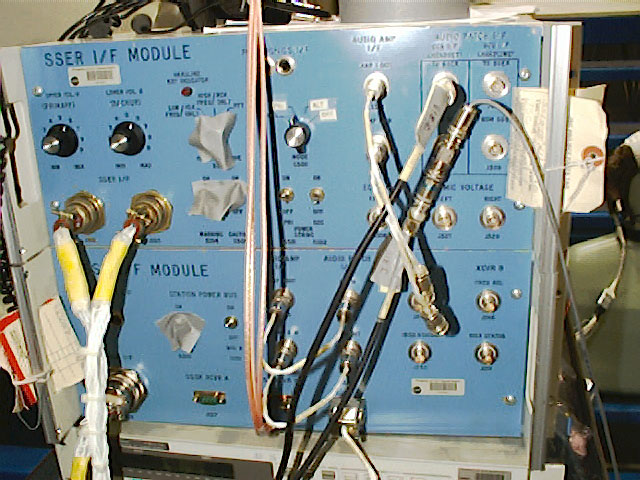 These are interface
panels for the Space-to-Space EMU Radio (SSER) and Space-to-Space Station
Radio (SSSR). Jeff had thoughtfully taped some of the switches so we wouldn't
be tempted to play with them.
These are interface
panels for the Space-to-Space EMU Radio (SSER) and Space-to-Space Station
Radio (SSSR). Jeff had thoughtfully taped some of the switches so we wouldn't
be tempted to play with them.
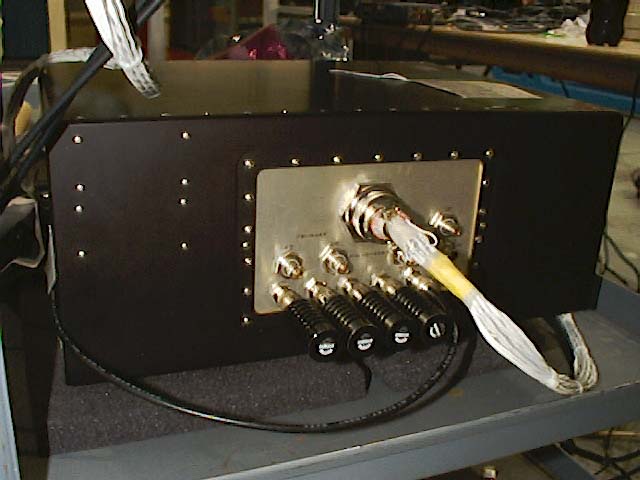 This is an
Engineering Evaluation Unit of the Space-to-Space Station Radio (SSSR).
The little black things in front are terminators.
This is an
Engineering Evaluation Unit of the Space-to-Space Station Radio (SSSR).
The little black things in front are terminators.
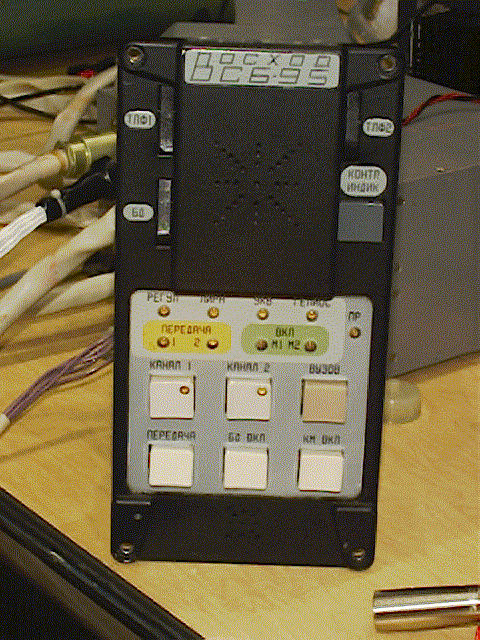 This is a Russian User
Panel. That's an American's translation. The Russians preferred "subscriber
panel," but that term didn't sit well with Ross or me. It seemed to us
that a subscriber should have to pay some regular fee. The Russian word
for "channel" sounds a bit like the English "canal" except for the accent,
and you can see the switches for channels 1 and 2. The word written in
large print at top is usually rendered as Voskhod in English.
This is a Russian User
Panel. That's an American's translation. The Russians preferred "subscriber
panel," but that term didn't sit well with Ross or me. It seemed to us
that a subscriber should have to pay some regular fee. The Russian word
for "channel" sounds a bit like the English "canal" except for the accent,
and you can see the switches for channels 1 and 2. The word written in
large print at top is usually rendered as Voskhod in English.
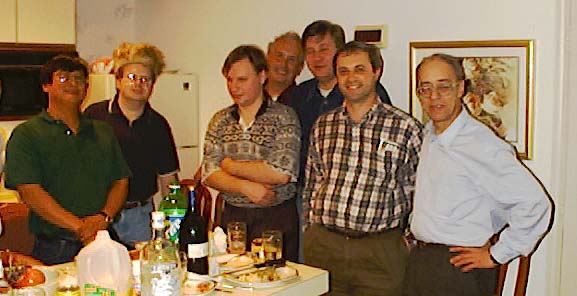 The Russians had a party one night at their hotel.
For some reason, they insisted that I wear a
hat made out of what they said was opossum fur.
It was too small for me,
but I assume that this was necessary to cover bald spots.
("It's not a bad rat hat at that."--Seinfeld)
From left to right, we have Andy Eng, me, Victor Gontcharouk,
Ross Drake, Eugene, Ilia, and Leonid.
The Russians had a party one night at their hotel.
For some reason, they insisted that I wear a
hat made out of what they said was opossum fur.
It was too small for me,
but I assume that this was necessary to cover bald spots.
("It's not a bad rat hat at that."--Seinfeld)
From left to right, we have Andy Eng, me, Victor Gontcharouk,
Ross Drake, Eugene, Ilia, and Leonid.
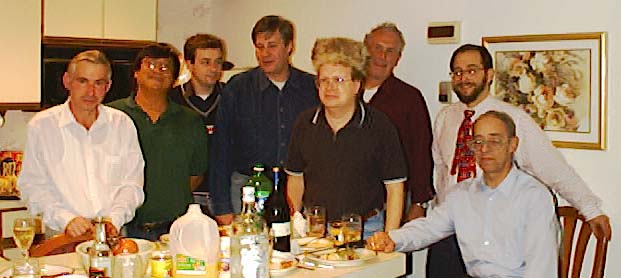 This was a similar shot, but with somebody else holding the camera.
Boris, Andy Eng, Igor, Eugene, me (wearing the disgusting hat),
Ross, Philip, and Leonid.
This was a similar shot, but with somebody else holding the camera.
Boris, Andy Eng, Igor, Eugene, me (wearing the disgusting hat),
Ross, Philip, and Leonid.
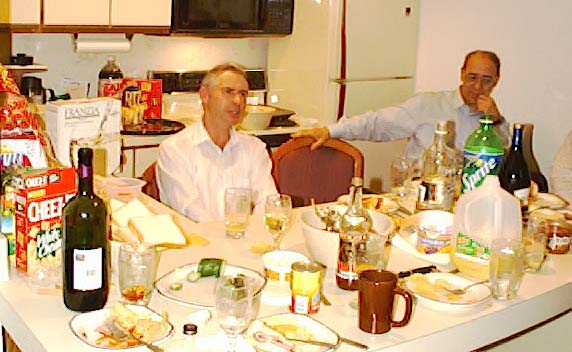 A view of the magnificent spread.
Among the victuals are that American miracle, wine in a box, and
some excellent Russian vodka (the brand name was Starka) in the bottle
in the middle of the table.
The latter had been aged with apple and pear leaves.
The Russians drink vodka straight up, at least when they're around me.
The trick seems to be to eat something immediately afterwards before
it has a chance to cause damage.
A view of the magnificent spread.
Among the victuals are that American miracle, wine in a box, and
some excellent Russian vodka (the brand name was Starka) in the bottle
in the middle of the table.
The latter had been aged with apple and pear leaves.
The Russians drink vodka straight up, at least when they're around me.
The trick seems to be to eat something immediately afterwards before
it has a chance to cause damage.
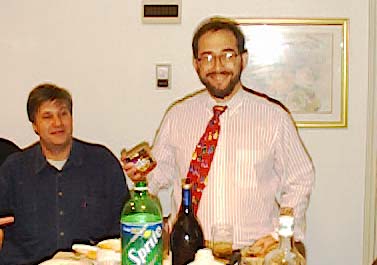 To tell the truth, I don't really know who this was--his name was
Phil--but he brought some salsa, as you can see.
Eugene looks on doubtfully.
To tell the truth, I don't really know who this was--his name was
Phil--but he brought some salsa, as you can see.
Eugene looks on doubtfully.
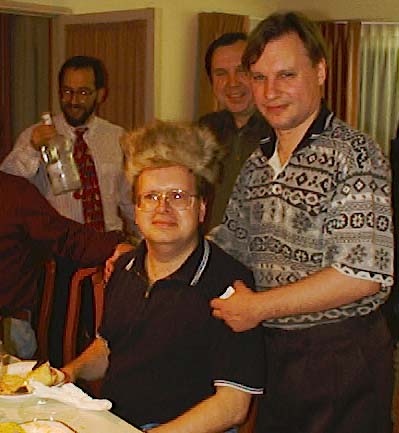 The cat in the hat at center.
I'm not sure what Victor G. is trying to do; I guess that's
the reason for my deer-in-the-headlights expression.
Phil and Victor K. are in the background.
The cat in the hat at center.
I'm not sure what Victor G. is trying to do; I guess that's
the reason for my deer-in-the-headlights expression.
Phil and Victor K. are in the background.
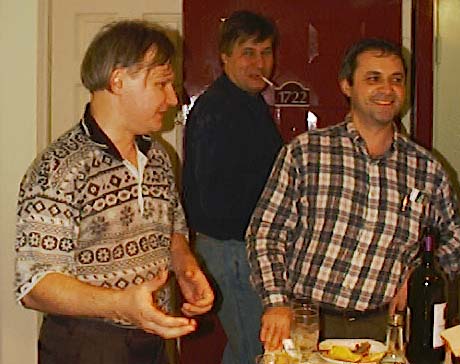 Victor G., Eugene, and Ilia.
You had to have been there.
Victor G., Eugene, and Ilia.
You had to have been there.
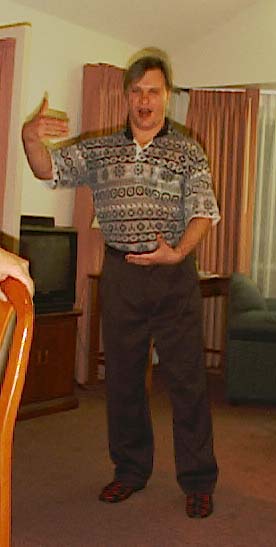 Victor G. took the opportunity to demonstrate a note he had learned
to sing.
It was quite powerful and yet somehow failed to crack the screen
of the TV behind him.
No idea what the rest of the song would have been.
Victor G. took the opportunity to demonstrate a note he had learned
to sing.
It was quite powerful and yet somehow failed to crack the screen
of the TV behind him.
No idea what the rest of the song would have been.
Author: Porter Clark <jpc@suespammers.org>
The suespammers.org mail server is located in California.
Do not send unsolicited bulk or commercial email to my suespammers.org
address.
Last update: December 31, 2001